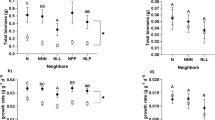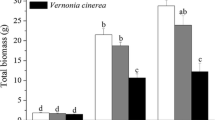Abstract
Invasive plant species often outcompete natives when colonizing new areas, but the mechanisms behind their success are unclear. The limiting similarity hypothesis predicts that functionally similar species are more prone to compete than dissimilar ones. This ecological assumption can assist in the selection of a seed mixture for ecological restoration of disturbed sites, to control opportunistic exotic plants at early stages of establishment. We performed a greenhouse experiment to evaluate the competition effects of Stipa gigantea Link (Poaceae), a functionally similar species, and Lupinus luteus L. (Fabaceae), a dissimilar one, over the invasive Cortaderia selloana (Schultes & Schultes fil.) Asch. & Graebn (Poaceae). Our design included monospecific and mixed pots at three densities (one, two or four plants per pot) and different densities of the invader (0, 25, 50, 75 and 100%). We compared above-ground dry biomass, an indicator of resource limitation in growth, Specific Leaf Area (SLA), and several indexes obtained from the leaf reflectance spectrum, indicators of physiological stress. Cortaderia showed strong intraspecific competition, with lower plant biomass at higher densities. When grown in competition, Cortaderia was outcompeted by Stipa, which performed better than in unmixed pots, but was not affected by Lupinus. Slight variations in SLA and photosynthetic performance were observed in Cortaderia, demonstrating a higher plasticity than the native species, which did not show any response. Based on our results, we suggest that Cortaderia is a weak competitor compared to a similar native species, and its advantage must lie in other traits such as its facility to generate large amounts of propagules and its efficiency in early stages of seedling growth. Functionally similar species may be an adequate choice for restoration in order to outcompete invasive plants.





Similar content being viewed by others
References
Adams ML, Philpot WD, Norvell WA (1999) Yellowness index: an application of spectral second derivatives to estimate chlorosis of leaves in stressed vegetation. Int J Remote Sens 20:3663–3675
Araus JL, Slafer GA, Royo C et al (2008) Breeding for yield potential and stress adaptation in cereals. Crit Rev Plant Sci 27:377–412
Asner GP, Martin RE, Carranza-Jimenez L et al (2014) Functional and biological diversity of foliar spectra in tree canopies throughout the Andes to Amazon region. New Phytol 204:127–139
Bacchetta G, Dettori CA, Mascia F et al (2010) Assessing the potential invasiveness of Cortaderia selloana in Sardinian wetlands through seed germination study. Plant Biosyst 144:518–527
Berendse F (1979) Competition between plant-populations with different rooting depths. 1. Theoretical considerations. Oecologia 43:19–26
Bermúdez R, Retuerto R (2013) Living the difference: alternative functional designs in five perennial herbs coexisting in a coastal dune environment. Funct Plant Biol 40:1187–1198
Blossey B, Notzold R (1995) Evolution of increased competitive ability in invasive nonindigenous plants—a hypothesis. J Ecol 83:887–889
Brown CS, Rice KJ (2010) Effects of belowground resource use complementarity on invasion of constructed grassland plant communities. Biol Invasions 12:1319–1334
Brunel S, Schrader G, Brundu G et al (2010) Emerging invasive alien plants for the Mediterranean basin. EPPO Bull 40:219–238
Campos JA, Herrera M, Biurrun I et al (2004) The role of alien plants in the natural coastal vegetation in Central-Northern Spain. Biodivers Conserv 13:2275–2293
Carter GA, Paliwal K, Pathre U et al (1989) Effect of competition and leaf age on visible and infrared reflectance in pine foliage. Plant Cell Environ 12:309–315
Carvalho S, Macel M, Schlerf M, Skidmore AK, van der Putten WH (2012) Soil biotic impact on plant species shoot chemistry and hyperspectral reflectance patterns. New Phytol 196:1133–1144
Daehler CC (2003) Performance comparisons of co-occurring native and alien invasive plants: implications for conservation and restoration. Annu Rev Ecol Evol Syst 34:183–211
Davidson AM, Jennions M, Nicotra AB (2011) Do invasive species show higher phenotypic plasticity than native species and if so, is it adaptive? A meta-analysis. Ecol Lett 14:419–431
Domenech R, Vilà M (2007) Cortaderia selloana invasion across a Mediterranean coastal strip. Acta Oecol 32:255–261
Domenech R, Vilà M (2008) Response of the invader Cortaderia selloana and two coexisting natives to competition and water stress. Biol Invasions 10:903–912
Domenech R, Vilà M, Pino J et al (2005) Historical land-use legacy and Cortaderia selloana invasion in the Mediterranean region. Glob Change Biol 11:1054–1064
Durako MJ, Howarth JF (2017) Leaf spectral reflectance shows Thalassia testudinum seedlings more sensitive to hypersalinity than hyposalinity. Front Plant Sci 8:1127
Fagúndez J, Barrada M (2007) Plantas invasoras de galicia. Bioloxía, distribución e métodos de control. Dirección Xeral de Conservación da Natureza. Consellería de Medio Ambiente e Desenvolvemento Sostible, Xunta de Galicia, Santiago de Compostela
Fargione J, Brown CS, Tilman D (2003) Community assembly and invasion: an experimental test of neutral versus niche processes. Proc Natl Acad Sci USA 100:8916–8920
Funk JL, Cleland EE, Suding KN et al (2008) Restoration through reassembly: plant traits and invasion resistance. Trends Ecol Evol 23:695–703
Gamon JA, Serrano L, Surfus JS (1997) The photochemical reflectance index: an optical indicator of photosynthetic radiation use efficiency across species, functional types, and nutrient levels. Oecologia 112:492–501
Garbulsky MF, Peñuelas J, Gamon J, Inoue Y, Filella I (2011) The photochemical reflectance index (PRI) and the remote sensing of leaf, canopy and ecosystem radiation use efficiencies. A review and meta-analysis. Remote Sens Environ 115:281–297
Gioria M, Osborne BA (2014) Resource competition in plant invasions: emerging patterns and research needs. Front Plant Sci 5:501
Goldberg DE, Landa K (1991) Competitive effect and response—hierarchies and correlated traits in the early stages of competition. J Ecol 79:1013–1030
Grotkopp E, Rejmanek M (2007) High seedling relative growth rate and specific leaf area are traits of invasive species: phylogenetically independent contrasts of woody angiospernis. Am J Bot 94:526–532
Gurevitch J (1986) Competition and the local-distribution of the grass Stipa neomexicana. Ecology 67:46–57
Herrera MJ, Campos A (2006) El carrizo de la pampa (Cortaderia selloana) en Bizkaia. Guía práctica para su control. Instituto de Estudios Territoriales de Bizcaia & Diputación Foral de Bizkaia, Bizkaia
Keddy PA (2017) Competition. In: Keddy PA (ed) Plant ecology: Origins, processes, consequences, 2nd edn. Cambridge University Press, Cambridge, pp 123–162
Lambrinos JG (2001) The expansion history of a sexual and asexual species of Cortaderia in California, USA. J Ecol 89:88–98
Larson DL, Bright JB, Drobney P et al (2013) Using prairie restoration to curtail invasion of Canada thistle: the importance of limiting similarity and seed mix richness. Biol Invasions 15:2049–2063
Lema M, Lindner R (2010) Potential of wild yellow lupin from Northwestern Spain. Crop Sci 50:1357–1365
MacDougall AS, Turkington R (2005) Are invasive species the drivers or passengers of change in degraded ecosystems? Ecology 86:42–55
Ordonez A (2014) Functional and phylogenetic similarity of alien plants to co-occurring natives. Ecology 95:1191–1202
Pausas JG, Lloret F, Vilà M (2006) Simulating the effects of different disturbance regimes on Cortaderia selloana invasion. Biol Conserv 128:128–135
Peñuelas J, Filella I (1998) Visible and near-infrared reflectance techniques for diagnosing plant physiological status. Trends Plant Sci 3:151–156
Peñuelas J, Baret F, Filella I (1995) Semiempirical indexes to assess carotenoids chlorophyll-a ratio from leaf spectral reflectance. Photosynthetica 31:221–230
Pokorny ML, Sheley RL, Zabinski CA et al (2005) Plant functional group diversity as a mechanism for invasion resistance. Restor Ecol 13:448–459
Poorter H, Niinemets U, Poorter L et al (2009) Causes and consequences of variation in leaf mass per area (LMA): a meta-analysis. New Phytol 182:565–588
Sanz-Elorza M, Dana ED, Sobrino E (2006) Invasibility of an inland area in NE Spain by alien plants. Acta Oecol 29:114–122
Saura-Mas S, Lloret F (2005) Wind effects on dispersal patterns of the invasive alien Cortaderia selloana in Mediterranean wetlands. Acta Oecol 27:129–133
Schmidt CD, Hickman KR, Channell R et al (2008) Competitive abilities of native grasses and non-native (Bothriochloa spp.) grasses. Plant Ecol 197:69–80
Seabloom EW, Harpole WS, Reichman OJ et al (2003) Invasion, competitive dominance, and resource use by exotic and native California grassland species. Proc Natl Acad Sci USA 100:13384–13389
Simmons MT (2005) Bullying the bullies: the selective control of an exotic, invasive annual (Rapistrum rugosum) by oversowing with a competitive native species (Gaillardia pulchella). Restor Ecol 13:609–615
Sims DA, Gamon JA (2002) Relationships between leaf pigment content and spectral reflectance across a wide range of species, leaf structures and developmental stages. Remote Sens Environ 81:337–354
Skalova H, Guo W-Y, Wild J et al (2017) Ambrosia artemisiifolia in the Czech Republic: history of invasion, current distribution and prediction of future spread. Preslia 89:1–16
Stubbs WJ, Wilson JB (2004) Evidence for limiting similarity in a sand dune community. J Ecol 92:557–567
Tilman D (1997) Community invasibility, recruitment limitation, and grassland biodiversity. Ecology 78:81–92
Turnbull LA, Rees M, Crawley MJ (1999) Seed mass and the competition/colonization trade-off: a sowing experiment. J Ecol 87:899–912
Underwood E, Ustin S, DiPietro D (2003) Mapping nonnative plants using hyperspectral imagery. Remote Sens Environ 86:150–161
Underwood EC, Ustin SL, Ramirez CM (2007) A comparison of spatial and spectral image resolution for mapping invasive plants in coastal California. Environ Manage 39:63–83
Vilà M, Weiner J (2004) Are invasive plant species better competitors than native plant species? Evidence from pair-wise experiments. Oikos 105:229–238
Violle C, Nemergut DR, Pu ZC et al (2011) Phylogenetic limiting similarity and competitive exclusion. Ecol Lett 14:782–787
Vourlitis GL, Kroon JL (2013) Growth and resource use of the invasive grass, pampasgrass (Cortaderia selloana), in response to nitrogen and water availability. Weed Sci 61:117–125
Walder M, Armstrong JE, Borowicz VA (2019) Limiting similarity, biotic resistance, nutrient supply, or enemies? What accounts for the invasion success of an exotic legume? Biol Invasions 21:435–449
Yannelli FA, Hughes P, Kollmann J (2017a) Preventing plant invasions at early stages of revegetation: the role of limiting similarity in seed size and seed density. Ecol Eng 100:286–290
Yannelli FA, Koch C, Jeschke JM et al (2017b) Limiting similarity and Darwin’s naturalization hypothesis: understanding the drivers of biotic resistance against invasive plant species. Oecologia 183:775–784
Acknowledgments
We used the facilities of the University of Santiago de Compostela for this experiment. We would also like to thank three anonymous reviewers who made useful comments that improved the final version of this article.
Author information
Authors and Affiliations
Corresponding author
Additional information
Publisher's Note
Springer Nature remains neutral with regard to jurisdictional claims in published maps and institutional affiliations.
Electronic supplementary material
Below is the link to the electronic supplementary material.
Rights and permissions
About this article
Cite this article
Fagúndez, J., Lema, M. A competition experiment of an invasive alien grass and two native species: are functionally similar species better competitors?. Biol Invasions 21, 3619–3631 (2019). https://doi.org/10.1007/s10530-019-02073-y
Received:
Accepted:
Published:
Issue Date:
DOI: https://doi.org/10.1007/s10530-019-02073-y




